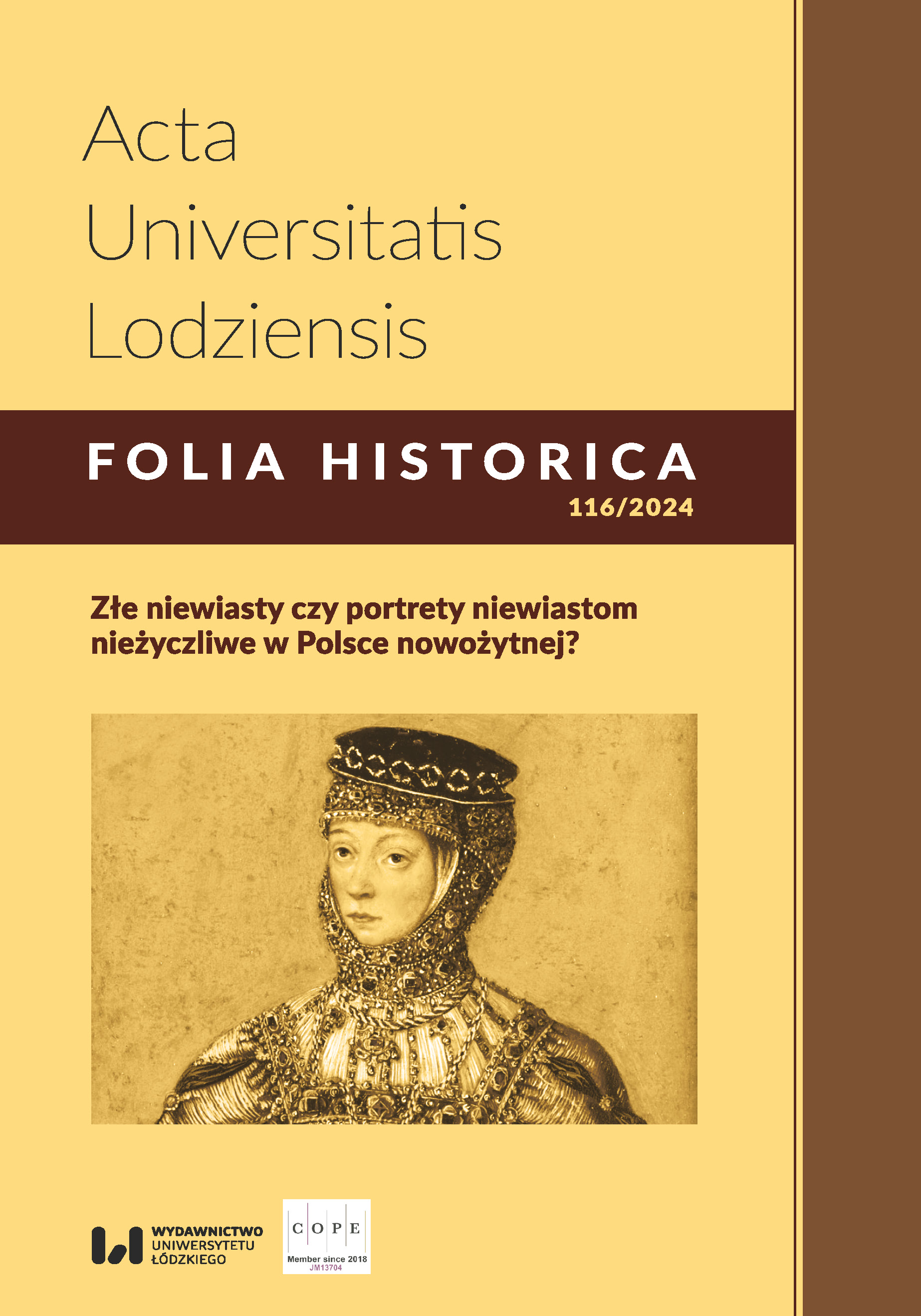Od zohydzonej królowej do stratega politycznego: ponowna ocena roli i wizerunku Bony Sforzy. Odpowiedź królowej na krytykę z 1537 roku
DOI:
https://doi.org/10.18778/0208-6050.116.03Słowa kluczowe:
Bona Sforza, historia kobiet, królowanie kobiet, władztwoAbstrakt
Artykuł analizuje kontrastujące narracje historyczne dotyczące królowej Bony Sforzy, koncentrując się na jej odpowiedzi z 1537 r. na zarzuty wobec niej podczas rokoszu szlachty pod Lwowem. Panowanie Bony, znacząco naznaczone konsolidacją gospodarczą i asertywnym zaangażowaniem politycznym, stanowi bogaty przypadek do analizy dynamiki kobiece-go przywództwa w zdominowanej przez mężczyzn sferze. Znaczenie tego tematu leży w jego potencjale do wzbogacenia zrozumienia ról płciowych, dynamiki władzy i konstrukcji narracji historycznych w ramach wczesnonowożytnej historii Europy. Pomimo znacznegodorobku naukowego dotyczącego Bony, w badaniach brakuje szczegółowego odniesienia do jej własnych wypowiedzi, zwłaszcza listu z 1537 r. adresowanego do sekretarza królewskiego Samuela Maciejowskiego, a także do tego, co ujawniają one na temat postrzegań władzy i autorytetu. Celem tekstu jest zbadanie tych aspektów, stawiając pytanie: Jak samo-prezentacja Bony w odpowiedzi na oskarżenia podczas buntu w 1537 r. ukazuje złożoność kobiecego władztwa i kwestionuje istniejące narracje historyczne? Wykorzystując analizę treści listu, autor przyjmuje perspektywę kobiety u władzy, aby ocenić zestawienie między portretem Bony kreowanym przez współczesnych jej ludzi a jej własną artykulacją swojej roli i działań. Wyniki pokazują, że list Bony nie tylko potwierdza jej kompetencje i zaangażowanie w sprawy państwa, ale także kwestionuje pejoratywne charakterystyki jej panowania, sugerując świadome starania w nawigowaniu i przeciwstawianiu się nałożonym na nią ograniczeniom jako kobiecie. Jej strategiczne zarządzanie zasobami gospodarczymi, zaangażowanie w sprawy dyplomatyczne i prawne oraz kreowanie narracji o dobroczynnym, ale stanowczym rządzeniu wyłaniają się jako kluczowe tematy. Te wnioski są istotne, ponieważ przyczyniają się do bardziej zniuansowanego zrozumienia przywództwa Bony, oferując wgląd w strategie stosowane przez kobiety u władzy do zdobycia autorytetu i wpływania na narracje historyczne. Ponadto autor podkreśla znaczenie analizy piśmiennictwa postaci historycznych w celu kwestionowania i rozszerzania ustalonych interpretacji historycznych, wzbogacając dyskurs dotyczący płci, władzy i historiografii w okresie wczesnonowożytnym.
Pobrania
Bibliografia
Górski S., Conciones in maximo totius regni Poloniae conventu apud Leopolim de republica habitae A.D. MDXXXVII, ed. W. Kętrzyński, Kraków 1878.
Google Scholar
Bogucka M., Bona Sforza, Warszawa 1998.
Google Scholar
Broomhall S., James C., Elite Women and the Italian Wars, 1494–1559, Cambridge 2024.
Google Scholar
DOI: https://doi.org/10.1017/9781009415972
Defilippis D., Mecenatismo e letteratura: la corte di Isabella e Bona Sforza a Bari, [in:] Principi e corti nel Rinascimento meridionale: i Caetani e le altre signorie nel Regno di Napoli, eds. F. Delle Donne, G. Pesiri, Roma 2020, pp. 189–202.
Google Scholar
Dembińska A., Zygmunt I. Zarys dziejów wewnętrzno-politycznych w latach 1540–1548, Poznań 1948.
Google Scholar
Dina A., Isabella d’Aragona alla corte aragonese, “Archivio storico lombardo” 1919, vol. XLVI, pp. 593–610.
Google Scholar
Dina A., Isabella d’Aragona Duchessa di Milano e di Bari, “Archivio storico lombardo” 1921, vol. XLVIII, pp. 269–457.
Google Scholar
Earenfight T., Without the Persona of the Prince: Kings, Queens and the Idea of Monarchy in Late Medieval Europe, “Gender & History” 2007, vol. XIX, no. 1, pp. 1–21.
Google Scholar
DOI: https://doi.org/10.1111/j.1468-0424.2007.00461.x
Frost R.I., The Oxford History of Poland–Lithuania, vol. I (The Making of the Polish-Lithuanian Union), Oxford 2015.
Google Scholar
DOI: https://doi.org/10.1093/acprof:oso/9780198208693.001.0001
Grabowski A., Groby, trumny i pomniki królów polskich w podziemiach i wnętrzu Katedry krakowskiej na Wawelu, 1868.
Google Scholar
Güttner-Sporzyński D. von, Contextualising the Marriage of Bona Sforza to Sigismund Iof Poland: Maximilian I’s Diplomacy in Italy and Central Europe, “Folia Historica Cracoviensia” 2021, vol. XXVII, pp. 63–90.
Google Scholar
DOI: https://doi.org/10.15633/fhc.4200
Güttner-Sporzyński D. von, Daughter, Mother, Widow: The Making of the Identities of Isabella d’Aragona, “Gender & History” 2023, pp. 1–16.
Google Scholar
DOI: https://doi.org/10.1111/1468-0424.12683
Hartleb K., Jan z Ociszyna Ocieski, jego działalność polityczna i diarjusz podróży do Rzymu (1501–1548), Lwów 1917.
Google Scholar
Kosior K., Bona Sforza and the Realpolitik of Queenly Counsel in Sixteenth-Century Poland–Lithuania, [in:] Queenship and Counsel in Early Modern Europe, eds. H. Matheson-Pollock, J. Paul, C. Fletcher, New York 2018, pp. 15–34.
Google Scholar
DOI: https://doi.org/10.1007/978-3-319-76974-5_2
Kosior K., Outlander, Baby Killer, Poisoner? Rethinking Bona Sforza’s Black Legend, [in:] Virtuous or Villainess? The Image of the Royal Mother from the Early Medieval to the Early Modern Era, eds. C. Fleiner, E. Woodacre, Basingstoke 2016, pp. 199–223.
Google Scholar
DOI: https://doi.org/10.1057/978-1-137-51315-1_10
Lubczyński M., Wykazy posłów sejmowych z lat 1507–1512, “Kwartalnik Historyczny” 2015, vol. CXXII, no. 3, pp. 509–537.
Google Scholar
DOI: https://doi.org/10.12775/KH.2015.122.3.04
Łopatecki K., Organizacja, prawo i dyscyplina w polskim i litewskim pospolitym ruszeniu(do połowy XVII wieku), Białystok 2013.
Google Scholar
Pociecha W., Królowa Bona (1494–1557), vol. I, Poznań 1949.
Google Scholar
Prochaska A., Rokosz lwowski w r. 1537, “Kwartalnik Historyczny” 1902, vol. XVI, no. 1, pp. 1–22; no. 2, pp. 208–242; no. 3, pp. 381–400.
Google Scholar
Queens and Power in Medieval and Early Modern England, eds. C. Levin, R. Bucholz, Lincoln 2009.
Google Scholar
Schramm G., Szlachta polska wobec reformacji 1548–1607, trans. J. Górny, ed. M. Ptaszyński, Warszawa 2015.
Google Scholar
Sucheni-Grabowska A., Odbudowa domeny królewskiej w Polsce 1504–1548, 2nd ed., Warszawa 2007.
Google Scholar
Szpaczyński P. P., Spór o królową Bonę, “In Gremium” 2018, vol. XII, pp. 287–312.
Google Scholar
DOI: https://doi.org/10.34768/ig.vi12.259
Szujski J., Dyaryusz sejmu piotrkowskiego 1548, [in:] Dyaryusze sejmów koronnych 1548, 1553 i 1570 r., Kraków 1872, pp. 161–297.
Google Scholar
Szulc T., Z badań nad egzekucją praw. Podstawy ustawodawcze egzekucji dóbr, ich interpretacja i nowelizacja na sejmach za panowania Zygmunta II Augusta, Łódź 2000.
Google Scholar
DOI: https://doi.org/10.18778/7171-389-4
Valerio S., Il ducato di Bari tra Isabella e Bona: percorsi della cultura aragonese a cavallo tra XV e XVI secolo, [in:] Intellettuali e potere nelle periferie del Regno. A Accademie, corti e città in Italia meridionale (sec. XIII–XVIII), eds. C. Acucella, C. Conte, T. De Angelis, Potenza 2023, pp. 55–70.
Google Scholar
Woodacre E., Queens and queenship, London 2021.
Google Scholar
DOI: https://doi.org/10.1515/9781641891905
Pobrania
Opublikowane
Jak cytować
Numer
Dział
Licencja

Utwór dostępny jest na licencji Creative Commons Uznanie autorstwa – Użycie niekomercyjne – Bez utworów zależnych 4.0 Międzynarodowe.
Funding data
-
Narodowym Centrum Nauki
Grant numbers 2021/43/B/HS3/01490 -
Australian Catholic University











